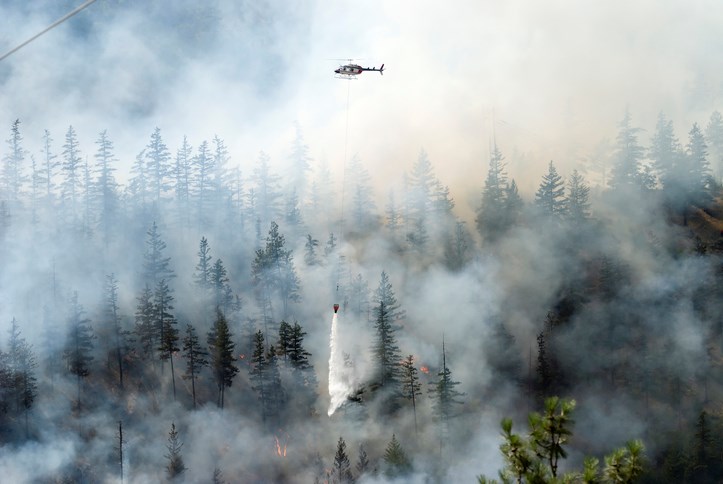A national organization representing more than 2,000 cities and towns across Canada is calling on the next federal government to commit billions of dollars to recover from the COVID-19 pandemic and face the fallout from climate change.
With 18 days left before the federal election, the Federation of Canadian Municipalities (FCM) released a detailed call for ramped-up funding to fix aging sewer and water systems, help public transit survive steep revenue shortfalls and adapt to the kind of heat waves and wildfires that scorched British Columbia this summer.
“After everything Canadians have been through, they deserve progress they can see — directly in the places where they live, work and raise families,” said FCM president and mayor of Strathroy-Caradoc Joanne Vanderheyden, in a written statement.
LONG-TERM FUNDING
Previously known as the Gas Tax Fund, the Canada Community-Building Fund currently provides $2.2 billion a year to municipalities and Indigenous communities across the country. That money gets distributed to provinces, territories and First Nations on a per-capita basis — B.C., for example, will receive roughly $280 million this year.
The FCM is calling on the next government to more than double that, raising the permanent source of funding to $4.6 billion annually.
The FCM is also asking for at least $10 billion over 20 years to upgrade water and sewer systems — both projected to be under increased pressure due to climate-induced drought and flooding — in Canadian towns and cities.
"Ultimately, the federal government has the resources," says New Westminster Coun. Patrick Johnstone, pointing to pressures his riverside community faces from flooding. "They have the tax revenue, they’ve got the money."
During the late June heat dome, Johnstone says he received preliminary reports that excess deaths spike from the single digits into the 50s. The Metro Vancouver community has one of the lowest tree-canopy covers out of the region's urban municipalities. Many low-income residents live in three-storey walk-up buildings built decades ago without proper insulation and with little thought of air conditioning. Without the cooling effect of trees, New Westminster residents face a "heat island" effect plaguing many urban areas across Canada.
"We are aggressively planting trees," says Johnstone. "But the best time to plant a shade tree is 20 years ago."
"We’re now desperately calling for money... We need money to address the infrastructure damage."
It's not just cities feeling the pressure of huge infrastructure costs in the face of a changing climate. Once the current funding stream runs out in 2028, FCM is looking for an additional $2.5-billion commitment over 10 years to bolster infrastructure projects in rural and northern communities.
TRANSPORTATION
Since the transmission of COVID-19 went global in the spring of 2020, a drop in ridership on public transit has crippled many cities’ and towns’ transit networks.
In Metro Vancouver, for example, TransLink ridership dropped to 17 per cent of pre-pandemic. In its 2021 budget, the regional transportation body predicted it would take anywhere from two to eight years to return to the kind of year-over-year growth it enjoyed before COVID-19.
Without a multi-year solution with federal support, FCM warns cities will be forced to scale back service levels and major infrastructure improvements.
At the same time, the municipal organization says the feds need to step up to support an inter-community passenger bus service. The call comes less than four months after Greyhound announced it would cut all of its routes and end operations after nearly a century serving small communities across Canada.
Predictable funding for transportation, says the FCM, should rise to $3 billion annually starting in 2026.
WARDING OFF FUTURE DISASTER
In a summer that set an all-time Canadian temperature record, led to hundreds of heat wave deaths and the burning of two towns by wildfire, the FCM says it’s time for Ottawa to step up its funding to mitigate disaster.
Canadian municipalities are looking for $2 billion over three years, plus another $1 billion in long-term funding to ward against wildfire, drought, flooding and restore wetlands and shorelines that act as buffers against such catastrophes.
“We are surrounded by wildfire,” says Kamloops Coun. Arjun Singh, stressing he does not speak on behalf of the FCM. “We’re not adequately funded to reduce those greenhouse gas emissions.”
Like many communities across Canada, Singh describes Kamloops as "truck country," where outsiders may think climate change is not people's top priority. But the councillor says in the past few years, public interest in climate change has grown dramatically.
"I’m seeing a real openness to the conversation. It’s no longer, 'Is it real or not,'" says Singh. "But they’re also worried about affordability."
To do both is going to take a lot more work and a lot more money at the local level, where life plays out, he says.
“We need to all recognize this is a very, very massive undertaking. And we all have to lean into that a lot more.”



